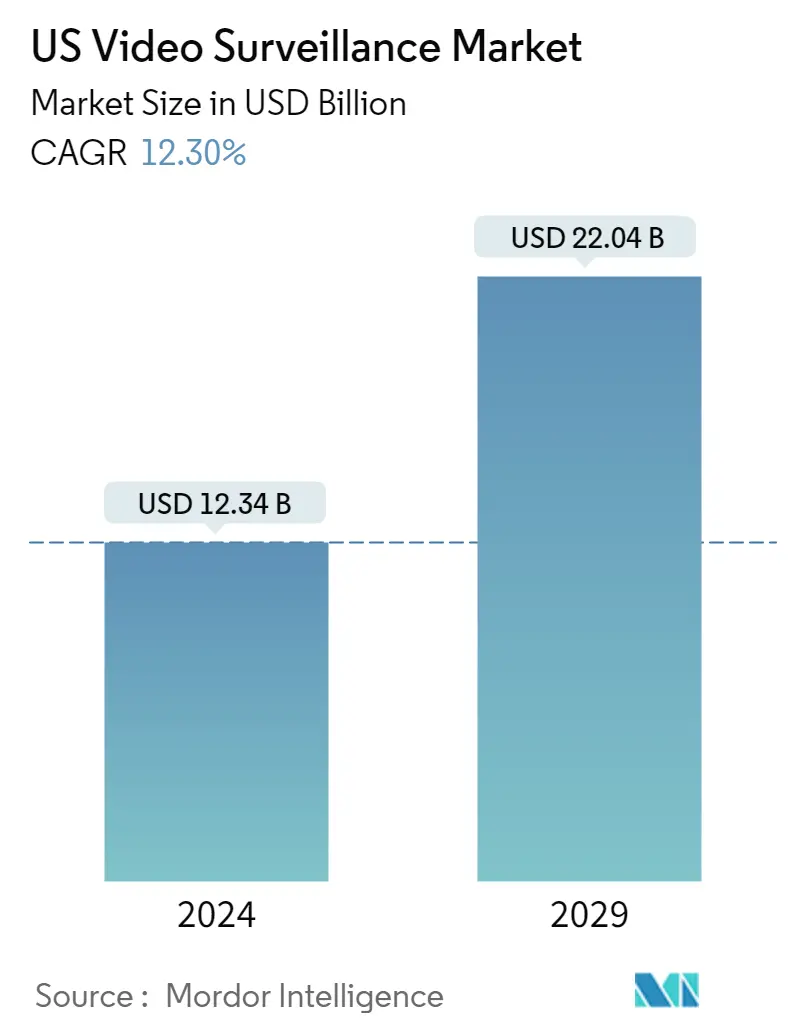Market Size of US Video Surveillance Industry

| Study Period | 2019 - 2029 |
| Base Year For Estimation | 2023 |
| Market Size (2024) | USD 12.34 Billion |
| Market Size (2029) | USD 22.04 Billion |
| CAGR (2024 - 2029) | 12.30 % |
| Market Concentration | Low |
Major Players
*Disclaimer: Major Players sorted in no particular order |
US Video Surveillance Market Analysis
The US Video Surveillance Market size is estimated at USD 12.34 billion in 2024, and is expected to reach USD 22.04 billion by 2029, growing at a CAGR of 12.30% during the forecast period (2024-2029).
In the United States, surveillance cameras are most common among private-sector retail and commercial establishments, such as hotels, restaurants, and office complexes.
- The country is also witnessing the rising adoption of smart home security cameras, which may further expand the scope of the market studied. AI-based video analytics further enhance efficiencies, offering many non-security-related insights for businesses, especially in smart city applications. Recently, Amazon announced the AWS Panorama technology that enables integrators to work with a developer to easily create customized deep learning and video analytic apps for video surveillance cameras, regardless of manufacturer.
- The use of video security cameras has expanded in recent years in the United States. Integrated video security cameras include technology that enables users to send information efficiently and quickly. This capability, however, may jeopardize the confidentiality of the scenario that has been hacked or captured. Malicious operations are performed via the smooth transmission of video footage and clips to unauthorized users.
- Over the past several years, video surveillance systems have become a part of the Internet of Things (IoT). An IoT sensor can often detect even more than humans, such as levels of pollutants in the air, noise level, and vibrations. For this reason, they are poised to be integrated into many camera-based surveillance solutions as they allow users to monitor threatened areas.
- However, like other IoT systems, inherent security risks can lead to significant violations of a user's privacy. Advanced machine learning techniques, primarily based on deep learning, are being researched and integrated within modern video surveillance systems for automating multiple tasks, including weapon detection, fire detection, in-store shopping, sensors of face recognition, and anomaly detection.
- Major industry verticals are trusting surveillance as a better platform for altering the behavior of employees to yield better results. Corporate companies' surveillance tactics had highly adverse effects on employees, resulting in the emergence of privacy issues, increased stress, and the loss of identity. However, like any intrusive technology, the benefits of deploying public video cameras must be balanced against the costs and dangers.
US Video Surveillance Industry Segmentation
Video surveillance systems contain one or more video cameras connected to a network that sends the captured video or audio data to a specific location. The captured images are monitored in real-time or sent to a central location for recording and storage. Many applications, such as crime prevention, industrial process monitoring, and traffic management, are increasingly utilizing video surveillance systems.
The United States Video Surveillance Market study tracks revenues accrued from the sales of four major product categories - Cameras, Video Analytics, Video Management Systems, and Storage Systems. The US Video Surveillance Market is Segmented by Type comprising Cameras, Video Management Systems and Storage, and Video Analytics, and by End Users, including Retail, Commercial, National Infrastructure, and City Surveillance, Transportation, Residential, among others.
The US Video Surveillance Market is Segmented by Type (Cameras, Video Management Systems and Storage, and Video Analytics), End User (Commercial, Retail, National Infrastructure, and City Surveillance, Transportation, and Residential). The market sizes and forecasts are provided in terms of value (USD million) for all the above segments.
| Type | |
| Cameras | |
| Video Management Systems and Storage | |
| Video Analytics |
| End User | |
| Commercial | |
| Retail | |
| National Infrastructure and City Surveillance | |
| Transportation | |
| Residential | |
| Other End Users |
US Video Surveillance Market Size Summary
The US video surveillance system market is experiencing significant growth, driven by the increasing adoption of advanced technologies and the rising demand for security solutions across various sectors. The market is characterized by the widespread use of surveillance cameras in private-sector retail and commercial establishments, as well as the growing popularity of smart home security cameras. The integration of AI-based video analytics is enhancing the efficiency of surveillance systems, providing businesses with valuable insights beyond security applications. The market is also witnessing the convergence of video surveillance systems with the Internet of Things (IoT), enabling more sophisticated monitoring capabilities. However, the proliferation of these technologies raises concerns about privacy and security risks, necessitating a balanced approach to their deployment.
The competitive landscape of the US video surveillance market is marked by the presence of major technology players and continuous innovations in surveillance solutions. Companies are increasingly focusing on developing advanced video analytics and machine learning techniques to enhance the capabilities of surveillance systems, such as weapon detection and facial recognition. The demand for video surveillance systems is further fueled by the need for improved public safety infrastructure and the potential threat of terrorist activities. Federal support and funding for safety initiatives are expected to drive the adoption of video analytics and surveillance equipment. The residential segment is also witnessing growth due to the rising need for security solutions, with smart home technologies playing a pivotal role in this expansion.
US Video Surveillance Market Size - Table of Contents
-
1. MARKET DYNAMICS
-
1.1 Market Overview
-
1.2 Industry Value Chain Analysis
-
1.3 Industry Attractiveness - Porter's Five Forces Analysis
-
1.3.1 Threat of New Entrants
-
1.3.2 Bargaining Power of Buyers
-
1.3.3 Bargaining Power of Suppliers
-
1.3.4 Threat of Substitute Products
-
1.3.5 Intensity of Competitive Rivalry
-
-
1.4 Market Drivers
-
1.4.1 Diminishing IP Camera Prices, Coupled with Technological Advancements in Analytics and Software
-
1.4.2 Emergence of Video Surveillance-as-a-Service (VSaaS) as a Viable Commercial Model
-
-
1.5 Market Challenges
-
1.5.1 Privacy and Security Issues
-
1.5.2 Need for High-capacity Storage for High-resolution Images
-
1.5.3 Restrictions Imposed on Chinese Companies Operating in the United States
-
-
1.6 Market Opportunities
-
1.7 Assessment of COVID-19 Impact on the Industry
-
1.8 Key Case Studies and Implementation Use-cases for City Surveillance
-
1.9 Best Practices Adopted by Key Players in Key Segments
-
-
2. MARKET SEGMENTATION
-
2.1 Type
-
2.1.1 Cameras
-
2.1.2 Video Management Systems and Storage
-
2.1.3 Video Analytics
-
-
2.2 End User
-
2.2.1 Commercial
-
2.2.2 Retail
-
2.2.3 National Infrastructure and City Surveillance
-
2.2.4 Transportation
-
2.2.5 Residential
-
2.2.6 Other End Users
-
-
US Video Surveillance Market Size FAQs
How big is the US Video Surveillance Market?
The US Video Surveillance Market size is expected to reach USD 12.34 billion in 2024 and grow at a CAGR of 12.30% to reach USD 22.04 billion by 2029.
What is the current US Video Surveillance Market size?
In 2024, the US Video Surveillance Market size is expected to reach USD 12.34 billion.

